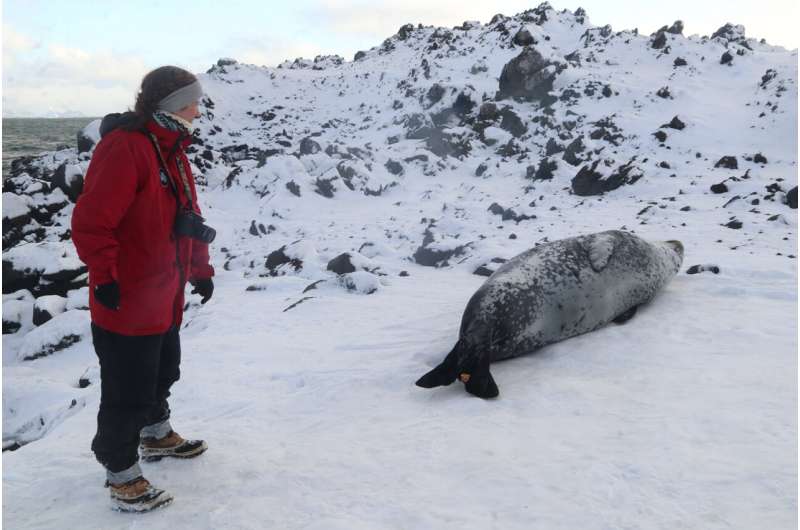This article has been reviewed according to Science X's editorial process and policies. Editors have highlighted the following attributes while ensuring the content's credibility:
fact-checked
peer-reviewed publication
trusted source
proofread
Research team establishes baseline data on cortisol levels on leopard seals, mysterious apex predators in Antarctica

Leopard seals are prehistoric, reptilian-looking marine predators often portrayed as scary villains in movies such as "Happy Feet" and "Eight Below," but little is known about their basic biology. The combination of the extreme climate in Antarctica, the species' solitary habits and their lethal reputation makes leopard seals one of the most difficult apex predators to study on Earth.
In 2018 and 2019, Sarah Kienle, Ph.D., assistant professor of biology at Baylor University, and her colleagues collected movement and dive behavior data and samples from leopard seals off the Western Antarctic Peninsula. Their goal was to compile crucial baseline data on the ecology and physiology of this enigmatic species.
Kienle and her colleagues published their first study on leopard seals in August 2022 in the journal Frontiers in Marine Science, in which they showed that leopard seals have flexible movement patterns and dive behaviors. This variability may offer leopard seals the resilience needed to survive the extreme climate and environmental disturbances occurring around Antarctica and beyond.
Emily Sperou, a Ph.D. student at Baylor, is lead author of a new study examining the stress physiology of leopard seals.
"Large and in charge: Cortisol levels vary with sex, diet and body mass in an Antarctic predator, the leopard seal" published this month in the journal Frontiers in Marine Science is the first in-depth study of leopard seal physiology.
In this groundbreaking study, Sperou and colleagues, including Kienle, examined how cortisol—an important stress hormone—varies between leopard seals. Their study also shows that leopard seals have the highest cortisol concentrations of any pinniped, including seals, sea lions and walruses.
Role of cortisol
As a stress hormone, cortisol is an essential biomarker in mammals that regulates physiological processes such as the immune system, reproductive function, and even behavior.
Cortisol levels in mammals can fluctuate due to a wide variety of internal and external stressors ranging from the daily fight for survival to changes in diet. Sperou wanted to know how cortisol varied in leopard seals based on different ecological and life history traits, like sex, age, body size and diet.
"Measuring and comparing cortisol concentrations provides important context for understanding the physiological responses of mammals," Sperou said.
The study
The goals for this study were to establish baseline cortisol concentrations for leopard seals and assess how cortisol levels change among individual leopard seals within a single population. To do this, Sperou measured cortisol concentrations, body mass and diet from 19 leopard seals that were sampled in the 2018–2019 expedition.
Prior to the latest Baylor research, only one previous study has been conducted on cortisol values in leopard seals. This earlier study only measured cortisol in four seals and did not include information on their sex or body size.
"The smaller your sample sizes and with no context for the animals, it's hard to figure out what cortisol concentrations mean and how that compares to other individual seals and other species," Kienle said.
Sperou also compared the leopard seal cortisol levels to 26 other closely related carnivore species with comparable data, including pinnipeds, bears, badgers and otters.
Findings
- Leopard seals have extremely highest cortisol levels.
- Leopard seals in this study have the highest cortisol levels ever reported for this species.
- An adult male leopard seal now holds the record for the highest cortisol level in any pinniped and other closely related mammals.
- Leopard seal cortisol levels vary based on sex, body size and diet.
- Females are significantly larger than males.
- Females feed on higher energy level prey in the food chain than males.
- Females have significantly lower cortisol concentrations than males.
- Leopard seals have cortisol values 1.25 to 50 times higher than closely related carnivores.
- Leopard seals have higher cortisol levels than 26 other closely related mammal species, including seals, sea lions, walruses, bears, badgers and otters. OH MY!
- Leopard seals, along with other Antarctic seals, have higher cortisol than other pinnipeds across the planet.
- High cortisol may be a specialized adaptation within this group of Antarctic-living marine mammals.
Conclusion
Evaluating the physiology of leopard seals and how their physiology changes based on their life history and ecology provides critical information about the health of individual seals and their population. Leopard seals are one of the least studied apex predators on Earth but play a disproportionately large role in Antarctic ecosystem structure and function.
For Sperou, this groundbreaking study provides a strong foundation for assessing leopard seals' physiology, which is fundamental for understanding their vulnerability to climate change.
"It's important we understand how these species are going to respond when their environment is rapidly changing," Sperou said.
What's next for this team of leopard seal biologists? Kienle said the team is now focused on traveling to different areas around the southern hemisphere to sample leopard seals across their range. Her team will use these data to better examine their ecology and physiology at different scales—from individuals to populations to the entire species. Their ultimate goal is to understand the adaptive capacity of leopard seals and ensure the health and well-being of this amazing species now and in the future.
More information: Emily S. Sperou et al, Large and in charge: cortisol levels vary with sex, diet, and body mass in an Antarctic predator, the leopard seal, Frontiers in Marine Science (2023). DOI: 10.3389/fmars.2023.1179236
Journal information: Frontiers in Marine Science
Provided by Baylor University


















